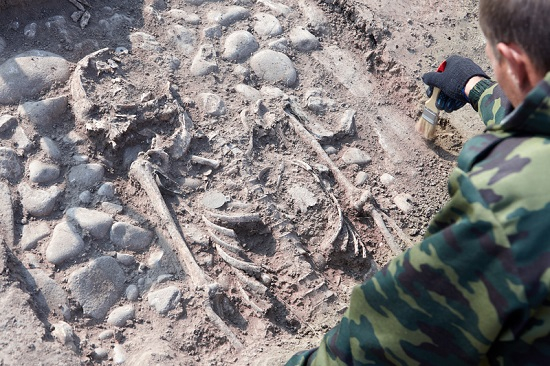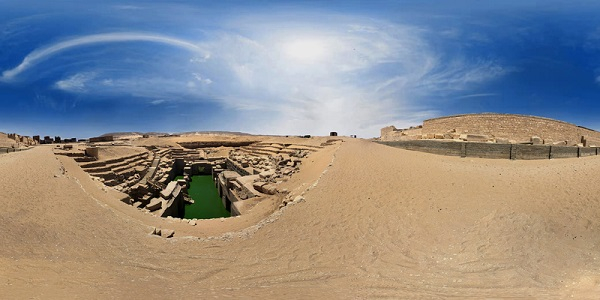

The origin and development of human culture are the focus of the associated fields of anthropology and archaeology, and play a significant role in the social sciences. Understanding the geological processes, in particular, the climatic periods that have left marks on the earth's surface is the goal of archaeological anthropology. The archaeologist works with items that have remained from earlier societies, including tools, shelters, and the remains of plants and animals that were consumed as sustenance. Archaeologists mostly use excavation to find artefacts with dates that may be used to assign a general period and then use that information to construct a cultural history of early man.

Figure 1: Human skeleton in an archaeological excavation
During the eighteenth century, scholars of various backgrounds began a systematic investigation of archaeological sites. They were primarily providing historical proof in the form of written records. Nicolas de Fabri (1580-1637) was one of these French scholars who conducted this type of systematic investigation. The trail goes back to Pompeii, the first systematic excavation of a city in 1719 when nobles hired people to collect antiquities. Thomsen eventually settled on a three-tiered classification of the collection's objects. Based on this strategy, there are three major periods or ages that existed pre-Christian past, and they are divided into these periods: the Stone, Bronze, and Iron Ages.
The goals and approaches used for dealing with the archaeological record underwent significant alterations from time to time over the last centuries. They created brief written descriptions of the relics in addition to pictures and sketches. These investigations were of the spontaneous variety, driven by basic human emotions like curiosity about one's surroundings, an adventurous and romantic spirit, an appetite for pleasure, a sense of reverence for one's predecessors, etc. The objectives have grown more complex over time, and archaeology has evolved from a purely practical activity of gathering and classifying ancient artefacts to a fully developed discipline. In addition to these unique field techniques, archaeology also uses several general approaches for analysing and interpreting the evidence.
The investigation of the social interactions of ancient cultures is revealed by the examination of the geographic distribution of archaeological sites. It offers crucial hints for reconstructing ancient lifeways' socioeconomic, demographic, and other features.
The study of simple modern hunter-gatherer and farmer/pastoral societies to reconstruct and interpret archaeological cultures.
The study of ancient human interactions with the natural world is known as environmental archaeology. It finds its focal point in the environmental influences on historical cultures and their effects on the social and economic facets of historical societies.
Understanding the behavioural patterns of various animal species is the focus of ethological studies. Analogies derived from the primatological study have been particularly useful for prehistorians in reconstructing the social behaviours of prehistoric hunter-gatherer cultures.
To reconstruct ancient communities, archaeologists frequently employ analogies from experimental investigations. Analogies from experimental investigations only offer provisional or speculative solutions that must be verified in light of actual archaeological findings.
Reconstructing the past of humanity is archaeology's primary goal, particularly in the absence of written documents. Even when written records are present, they infrequently include the actions of common people or different facets of daily life.
Archaeology examines human behaviour, there is a chance for objective and relative thought as well as the chance for interpretation. As a result, it may also be regarded as art.
Archaeology is the principal source of information for the long era of prehistoric cultural progress. It acts as an important secondary source for historical periods.
It fills in the gaps in the written records. Several noteworthy sites and monuments have been recorded and conserved for posterity as a result of archaeologists' efforts.

Figure 2: The Egyptian temple of Seti I, Abydos archaeological site
The origin and development of human culture are the focus of the associated fields of anthropology and archaeology, which play a significant role in the social sciences. The investigation of the social interactions of ancient cultures is revealed by the examination of the geographic distribution of archaeological sites. The study of ancient human interactions with the natural world is known as environmental archaeology. It finds its focal point in the environmental influences on historical cultures and their effects on the social and economic facets of historical societies. Understanding the behavioural patterns of various animal species is the focus of ethological studies.
Q.1. What exactly are Archaeological Sites?
An archaeological site is any type of location, great or little, where traces of human occupation or activity have been discovered. Sites do not remain unchanged over time, but rather change as a result of man's recurrent occupation or the impact of diverse natural causes.
Q.2. What does Petrology mean?
The study of rocks, or petrology, is important to archaeology and anthropology. Understanding the processes used to make stone tools, commonly known as reduction technology, is greatly aided by the study of the rocks.
Q.3. What does linguistic anthropology involve?
An interdisciplinary topic called linguistic anthropology is devoted to examining language from an anthropological standpoint. In other words, over time, linguistic anthropologists have considered language to be a highly developed sign system that aids in the formation of society and the transmission of certain cultural practices.